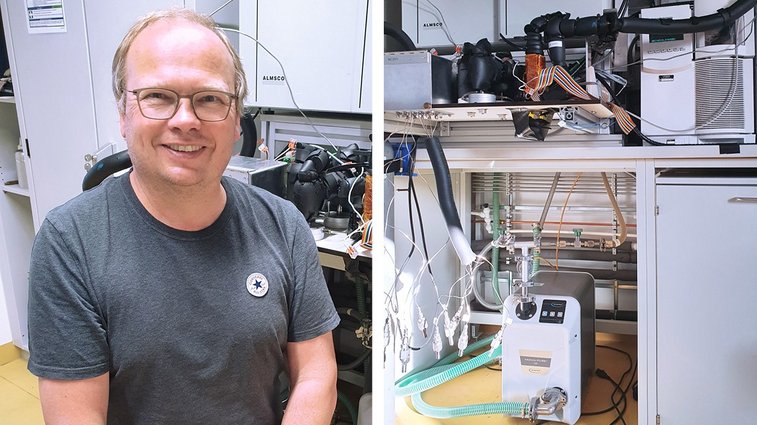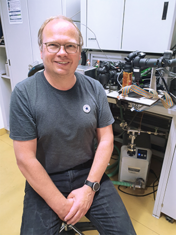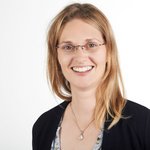
The VACUU·PURE® 10 screw pump supports two mass spectrometers in parallel as a fore pump.
© Goethe-Universität Frankfurt
Which and how many halogenated hydrocarbons occur in different layers of the atmosphere? The Experimental Atmospheric Research group at Goethe University Frankfurt is investigating questions like these. Researchers measure air samples from ground stations, airplanes and balloons. The VACUU·PURE® 10 screw pump supports two mass spectrometers in parallel as a fore pump in the gas chromatography laboratory. In our interview, professor Andreas Engel, head of the working group, gives us an insight into his research.
What is the goal of your research?
Professor Andreas Engel: We are interested in halogenated hydrocarbons in the atmosphere. The best known of these gases are probably chlorofluorocarbons (CFCs). Some people remember them from the debates in the 1980s and 1990s when ozone depletion in the stratosphere was the issue. The "ozone hole" still exists, although it doesn't appear in the media as much these days. We now know that these gases are also extremely potent greenhouse gases. One kilogram of CFCs released into the atmosphere has about the same impact as 5 to 10 tons of CO2. Therefore, it is important to know exactly the concentration and trend of these and other gases in the atmosphere. Corresponding measurements also help to verify compliance with global agreements - such as the Montreal Protocol to protect the ozone layer or the United Nations Framework Convention on Climate Change (UNFCCC) to stabilize greenhouse gas concentrations.
What measurements do you perform?
Professor Andreas Engel: We collect air samples from different layers of the atmosphere - from ground measuring stations, airplanes and balloons. We receive regular samples from our own "Taunus observatory" on the mountain Kleiner Feldberg. This belongs to the international measurement network "Advanced Global Atmospheric Gases Experiment" (AGAGE). We also receive air samples from abroad, for example from the "Mace Head" research station in Ireland.
We determine the content of halogenated hydrocarbons in our air samples using gas chromatography coupled with mass spectrometry. The art here is to measure very precisely: better than sub-ppt in the ultra-trace range. This means that we can still detect one particle in more than a trillion particles. To achieve high accuracy, we additionally measure reference samples using calibrated standards.
Mass Spectrometer
A mass spectrometer is a device to determine the mass of atoms or molecules in ionized state at a known charge. The result is a so-called mass spectrum. This is a graphical representation of the intensity of the ions as a function of the mass-to-charge ratio. Mass spectrometers require a stable high vacuum, sometimes down to 10-9 mbar.
What types of mass spectrometers do you use?
Professor Andreas Engel: In our laboratory at Goethe University Frankfurt, we have a special feature. Behind the chromatograph, we separate the gas flow and operate two mass spectrometers in parallel: A quadrupole mass spectrometer measures only a certain ratio of mass and charge. This means that we can only see substances that we expect to see. Therefore, we use a time-of-flight mass spectrometer in parallel. This measures all masses simultaneously – 20,000 mass spectra per second. This allows us to record all substances and provides us with much more information. We can also use this "digital air archive" retrospectively if additional data is to be evaluated at a later date.

Professor Engel in the gas chromatography laboratory with the VACUU·PURE® 10 screw pump as fore pump for mass spectrometers
In which way is VACUU·PURE an optimal solution for you?
Professor Andreas Engel: Our mass spectrometers require a stable high vacuum of down to 10-7 mbar. For this, we use turbomolecular pumps, which in turn require a fore pump. For this purpose, one of our technicians suggested the new VACUU·PURE screw pump - saying "That's exactly what we need“. The great thing is that we can operate both mass spectrometers in parallel with the VACUU-PURE screw pump. We only need one fore pump and no longer a separate one for each mass spectrometer.
In addition, the screw pump with 10-3 mbar has a much better vacuum than the previously used diaphragm pumps with about 1.5 mbar. As a result we can see that the power consumption of the turbomolecular pump has dropped by about 25%. It no longer has to work so hard, which can certainly have a positive effect on its service life.
What else is important to you about the fore pump?
Professor Andreas Engel: What really convinced me is that it is maintenance-free. We have been using VACUU·PURE for about a year and a half and have actually not had any problems yet. Maintenance means an intervention in the whole system, which we would like to avoid if possible. This is because when we shut down the quadrupole mass spectrometer, it takes half a day to get it operational again - even two days for the time-of-flight mass spectrometer. That's why we keep our mass spectrometers under vacuum all the time.
The dry technology of the VACUU·PURE screw pump is also crucial for us. Uncontrolled hydrocarbons would contaminate our samples and falsify the measurement result and make it unusable. That is why the absence of oil and contaminates is very important for us.
Do you use any other VACUUBRAND products?
Professor Andreas Engel: Yes, on our German research aircraft HALO to measure atmospheric halogenated trace gases. We collect air samples from up to 15 kilometers altitude and measure them directly on site. For the gas chromatography-mass spectrometry system on board, we use the MD 1 as a fore pump. We have had very good experience with VACUUBRAND so far.
We thank Professor Andreas Engel and the Goethe University Frankfurt for the interview.
